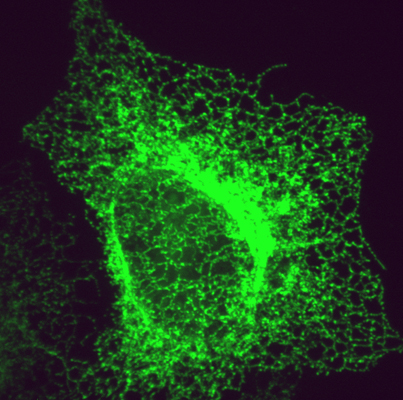Tina H. Lee
Associate Professor
Address:
271 Mellon Institute
Department of Biological Sciences
Carnegie Mellon University
4400 Fifth Avenue
Pittsburgh, PA 15213
Phone: 412-268-7882
Fax: 412-268-7129

Education
Ph.D., University of California, San Francisco
Postdoctoral Appointment, Carnegie Mellon University
Research
 The endoplasmic reticulum (ER) is a large interconnected membrane network that extends throughout the cytoplasm of all animal cells. It is a vital organelle that carries out a number of essential processes including protein and lipid biosynthesis, protein trafficking, drug detoxification and Ca+2 homeostasis. The long-term goal of our research is to better understand the structure and function relationship of the ER and how the structure of the organelle might be modified to respond to changes in cell physiology.
The endoplasmic reticulum (ER) is a large interconnected membrane network that extends throughout the cytoplasm of all animal cells. It is a vital organelle that carries out a number of essential processes including protein and lipid biosynthesis, protein trafficking, drug detoxification and Ca+2 homeostasis. The long-term goal of our research is to better understand the structure and function relationship of the ER and how the structure of the organelle might be modified to respond to changes in cell physiology.
In order to achieve this long-term goal, we first need to identify the proteins that underlie ER structure and understand how they work. Once their mechanism and regulation has been elucidated, a specific feature of the organelle generated by an individual structuring protein can be perturbed to determine the importance of that structural feature for individual ER functions.
The identification of ER structuring proteins is being achieved in our lab using a cell-based RNA interference (RNAi) approach where individual candidate structuring proteins are depleted using RNAi and the consequence on ER structure and organization explored using light and electron microscopic analyses. Currently, our lab is focused on two proteins whose depletion by RNAi alters ER structure in dramatically distinct ways. The first is Yip1A, a membrane-anchored protein with no known enzymatic function but whose knockdown leads to loss of ER dispersal and subsequent stacking of ER membranes into concentric membrane whorls. The second protein of interest is atlastin, a large membrane-anchored GTPase whose knockdown leads to a severe reduction in ER network interconnections. Both proteins are highly conserved, and in the case of atlastin, its mutation is linked to early onset forms of hereditary spastic paraplegia (HSP), a human neurological disorder. To gain mechanistic insights into how these proteins structure the ER, we are combining cell-based mutational analyses of the proteins with a variety of biochemical assays and fluorescence microscopy approaches to discern how the mutations affect their function.
Publications
Crosby D, Mikolaj MR, Nyenhuis SB, Bryce S, Hinshaw JE, Lee TH. Reconstitution of human atlastin fusion activity reveals autoinhibition by the C terminus. J Cell Biol. 2022 Feb 7;221(2):e202107070. doi: 10.1083/jcb.202107070. Epub 2021 Nov 24. PMID: 34817557
Winsor J, Machi U, Han Q, Hackney DD, Lee TH. GTP hydrolysis promotes disassembly of the atlastin crossover dimer during ER fusion. J Cell Biol. 2018 Sept 24.
PMID: 30249723
Windsor J, Hackney DD, Lee TH. The crossover conformational shift of the GTPase atlastin provides the energy driving ER fusion. J. Cell Biol. 216(5): 1321-1335. 2017 Mar 29.
Ulengin I, Park JJ, Lee TH. ER network formation and membrane fusion by atlastin1/SPG3A disease variants. Mol Biol Cell. 2015 Mar 11.
Faust JE, Desai T, Verma A, Ulengin I, Sun TL, Moss TJ, Betancourt MA, Huang HW, Lee T, McNew JA. The Atlastin C-terminal tail is an amphipathic helix that perturbs bilayer structure during endoplasmic reticulum homotypic fusion. J Biol Chem. 2015 Jan 2.
Saini SG, Liu C, Zhang P, Lee TH. Membrane tethering by the atlastin GTPase depends on GTP hydrolysis but not on forming the crossover configuration. Mol Biol Cell. 2014 Sep 24.
Dykstra KM, Ulengin I, Delrose N and Lee TH. Identification of discrete sites in Yip1A necessary for regulation of endoplasmic reticulum structure. PloS One 8(1):e54413. Epub 2013 Jan 14.
Morin-Leisk J, Saini SG, Meng X, Makhov AM, Zhang P and Lee TH. An intramolecular salt bridge drives the soluble domain of GTP-bound atlastin into the postfusion conformation. The Journal of Cell Biology, 195(4): 605-615, 2011.
Dykstra KM, Pokusa JE, Suhan J, Lee TH. Yip1A structures the mammalian endoplasmic reticulum. Molecular Biology of the Cell, 21(9):1556-68, 2010. Faculty of 1000 Must Read.
Morin-Leisk J and Lee TH. Nucleotide dependent self-assembly of Nucleoside Diphosphate Kinase (NDPK) in vitro. Biochimica et Biophysica Acta, 1784(12):2045-2051, 2008.
Baughman C, Morin-Leisk J and Lee TH. Nucleoside Diphosphate Kinase B (NDPKB) scaffolds endoplasmic reticulum membranes in vitro. Exp Cell Res, 314(14):2702-2714, 2008. Faculty of 1000 Recommended.
Kapetanovich L, Baughman C and Lee TH. Nm23H2 Facilitates Coat Protein Complex II Assembly and Endoplasmic Reticulum Export in Mammalian Cells. Molecular Biology of the Cell, 16(2):835-48, 2005.
Bachert C, Lee TH and Linstedt AD. Lumenal endosomal and Golgi-retrieval determinants involved in pH-sensitive targeting of an early Golgi protein. Mol Biol Cell, 12(10)3152-60, 2001.
Lee TH and Linstedt AD. Potential role for protein kinases in regulation of bidirectional endoplasmic reticulum-to-Golgi transport revealed by protein kinase inhibitor H89. Molecular Biolology of the Cell, 11(8):2577-90, 2000.
Lee TH and Linstedt AD. Osmotically induced cell volume changes alter anterograde and retrograde transport, Golgi structure, and COPI dissociation. Molecular Biology of the Cell, 10(5):1445-62, 1999.